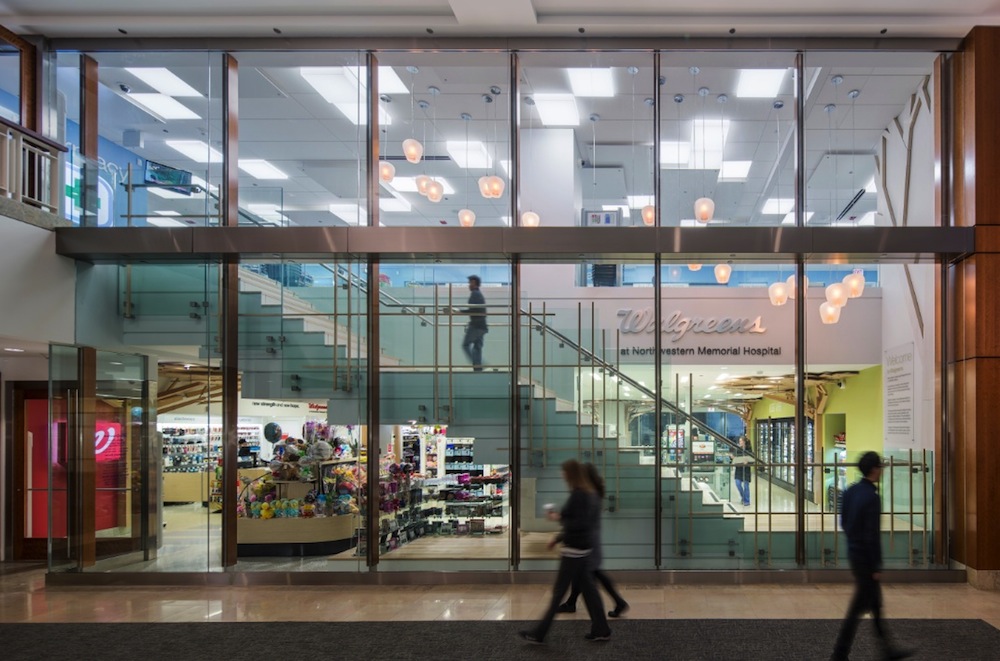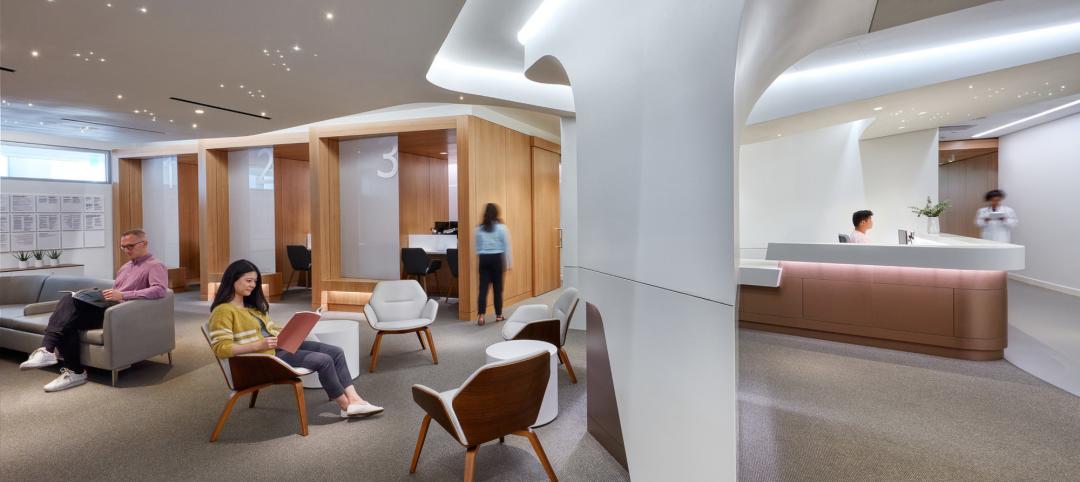Most retail in healthcare discussions today are focused on integrating ambulatory care into traditional retail settings or repurposing retail space for medical office use. Another trend that is not as well noted is the migration of retailers onto acute care campuses.
On-campus medical office buildings (MOB) have traditionally been designed to squeeze as many physicians as possible into a designated space. This approach ensured that physicians were bonded to a particular hospital thus leading to admissions and other “downstream” revenue. To accommodate this model, the design of most MOBs limited public spaces, lobbies, and other amenities.
One notable exception to this rule is Medical City, located in Dallas. Medical City pioneered the concept of ground-floor retail as part of the medical center campus. As you open the door to the “city” you will find a different type of atmosphere; it not only looks like, but also has services of a five star hotel. Twelve retailers are located within the city. You can find everything from shoe shining to flower/gifts to tacos.
“Having Walgreens within the medical office building at Northwestern is extremely convenient for patients, as they can pick up their prescriptions prior to leaving the campus. In addition, there is growing evidence that this convenience increases patient compliance with their drug regimen." —Skender Rugova, Senior Director, CBRE
Although viewed as innovative and highly successful when it first opened in the 1980’s, no other healthcare provider has been able to emulate the success that this concept has achieved.
In the early 1990s, hospitals began decanting outpatient services from the inpatient facilities into on-campus medical office space. This move put new demand on ground floor space for surgery centers, imaging, and urgent care centers. To open up these spaces, hospitals displaced non-admitting physicians and ancillary health professionals.
As health systems now look to more distributive strategies for these services and physicians consolidate their practices, more space is becoming available within existing campus facilities. It is only logical that building owners are beginning to consider other uses to backfill these spaces in ways that benefit both employees and visitors and enhance building revenue.
Some uses are obvious and have a natural affinity for locating in a medical office building. For instance, pharmacies and urgent care centers have a strong desire for first floor space and the possibility for separate access to allow for extended hours.
“Having Walgreens within the medical office building at Northwestern is extremely convenient for patients, as they can pick up their prescriptions prior to leaving the campus," noted Skender Rugova, Senior Director responsible for the facility. "In addition, there is growing evidence that this convenience increases patient compliance with their drug regimen."
But, of equal importance is the question of what opportunities exist for partnering with nontraditional retailers that might be a good fit for a healthcare campus. This was the challenge presented by a healthcare REIT to its leasing team.
As this was outside the mainstream of medical office leasing, a team that included the owner, a healthcare and life science expert, and a retail specialist were convened to create a list of prospective non-physician tenants for an on-campus medical office buildings.
ADDING RETAIL TO THE MIX
With a focus on businesses that would be attractive to patients and staff, the team looked beyond the traditional type of tenants to identify 12 prospective “verticals.” Prospects included a range of services from financial to food and even included potential competitors, such as dialysis, surgery centers, and allied health services.
While some services were currently availability on site, opportunities existed to provide a more user friendly environment and thus improve the overall campus experience.
Most campuses have a single point of food service, the hospital cafeteria. Usually located in the basement and positioned primarily to serve inpatients and employees, campus visitors typically find their location to be remote and inconvenient.
Medical campuses generate considerable daily foot traffic from employees, patients and visitors. Hospitals average about four to five employees per bed and physicians are typically supported by 2.5 employees. Combine this with a physician seeing approximately 30 patients a day and you can see how the numbers begin to add up. Some large campuses may have more than 10,000 employees and visitors per day.
On the list of 12 verticals identified, food services topped the chart with 19 separate vendors. Given the focus for healthcare systems to encourage healthy living, the list excluded most of the well-recognized fast food names and concentrated on those firms that provided predominately healthy items on their menus. Initial reactions from the firms were that the campus locations were too far outside the norm for their consideration. However, a few were willing to think outside the box and decided it was worth an additional feasibility study.
One such participant, Subway, which already has a history of locating in nontraditional venues, was the first to step up to the plate. They recently opened a store in Indianapolis on the St. Vincent’s Healthcare campus. Subway is now considering other locations throughout the country (as well as with the health system) and has demonstrated to other organizations the value that these nontraditional sites may hold.
Oregon Health & Science University (OHSU) has two campuses—Marquam Hill and South Waterfront—that are connected via the Portland Aerial Tram. Due to the separation of campuses, OHSU has recognized the importance of providing retail amenities to those who work and visit the South Waterfront campus. Some of the first tenants to open business included coffee shop, deli, and a café.
“It’s been a great strategy for OHSU to designate space to provide amenities for their patients and visitors while also having the benefit of generating revenue,” said Dyann Hamilton, Senior Director for OHSU.
OPPORTUNITIES WITH COMMERCIAL PHARMACIES
There is considerable evidence that patients who are compliant with their prescription medicines have significantly better outcomes than those who aren’t. As health systems take greater risk and responsibility for the health of the populations they manage, they have recognized it’s more important to partner with those who can assist in this objective rather than trying to preserve the turf of the hospital-based pharmacy.
Traditionally, hospitals have viewed commercial (chain) pharmacies as competitors, and chains have not shown interest in hospital/medical spaces. Both of these views have changed dramatically within the last two to three years.
The major pharmacy chains have recently shown an interest in locating on hospital campuses. Walgreens and CVS are the forerunners in capitalizing on these nontraditional spaces. They have demonstrated value to health systems in their ability to achieve a much higher prescription fulfillment rate than a hospital based pharmacy operating in the medical space.
The fulfillment rate of prescriptions after an ambulatory procedure or doctor visit is surprisingly dismal. Less than 50% of patients actually fill their prescriptions. When locating on a campus, the major chains have developed protocols and partnerships with the hospital to assist in filling prescriptions by actually delivering them to the patients prior to discharge after an ambulatory procedure.
With electronic ordering, prescriptions can be ready for pick up within the building after visiting a doctor. The chain pharmacies have created robust information systems that are capable of tracking and following up with patients for refills and directing them to a pharmacy close to their homes.
Times are changing for medical real estate. Opportunities to look beyond the traditional health services are growing at a furious rate. Early success with these two verticals may well serve as an indicator of the future for other “retail” uses. Other potential partners that should be considered include banking and financial services, vision care, dry cleaning and laundry services, UPS stores, and spa services. Healthcare systems that look “outside the box” when developing their facilities strategies will be the leaders in today’s ever changing environment.
About the Author
As a Managing Director with CBRE Healthcare, Craig Beam oversees the development and management of a broad range of real estate with a focus on healthcare and institutional projects. His responsibilities include the development of hospital, medical office and ambulatory facilities. In addition, he has led the resolution of a variety of work-out situations including construction completion, financial restructuring and dispositions. Beam has developed an expansive resume of OSHPD experience over the past 30 years. Projects range from the $800 million replacement of Cottage Hospital in Santa Barbara to a remodeling of the Emergency Department at Huntington Park Hospital in Los Angeles.
Related Stories
Healthcare Facilities | Sep 13, 2023
Florida’s first freestanding academic medical behavioral health hospital breaks ground in Tampa Bay
Construction kicked off recently on TGH Behavioral Health Hospital, Florida’s first freestanding academic medical behavioral health hospital. The joint venture partnership between Tampa General (a 1,040-bed facility) and Lifepoint Behavioral Health will provide a full range of inpatient and outpatient care in specialized units for pediatrics, adolescents, adults, and geriatrics, and fills a glaring medical need in the area.
Healthcare Facilities | Sep 8, 2023
Modern healthcare interiors: Healing and care from the outside in
CO Architects shares design tips for healthcare interiors, from front desk to patient rooms.
Giants 400 | Aug 22, 2023
Top 115 Architecture Engineering Firms for 2023
Stantec, HDR, Page, HOK, and Arcadis North America top the rankings of the nation's largest architecture engineering (AE) firms for nonresidential building and multifamily housing work, as reported in Building Design+Construction's 2023 Giants 400 Report.
Giants 400 | Aug 22, 2023
2023 Giants 400 Report: Ranking the nation's largest architecture, engineering, and construction firms
A record 552 AEC firms submitted data for BD+C's 2023 Giants 400 Report. The final report includes 137 rankings across 25 building sectors and specialty categories.
Giants 400 | Aug 22, 2023
Top 175 Architecture Firms for 2023
Gensler, HKS, Perkins&Will, Corgan, and Perkins Eastman top the rankings of the nation's largest architecture firms for nonresidential building and multifamily housing work, as reported in Building Design+Construction's 2023 Giants 400 Report.
Healthcare Facilities | Aug 21, 2023
Sutter Health’s new surgical care center finishes three months early, $3 million under budget
Sutter Health’s Samaritan Court Ambulatory Care and Surgery Center (Samaritan Court), a three-story, 69,000 sf medical office building, was recently completed three months early and $3 million under budget, according to general contractor Skanska.
Healthcare Facilities | Aug 18, 2023
Psychiatric hospital to feature biophilic elements, aim for net-zero energy
A new 521,000 sf, 350-bed behavioral health hospital in Lakewood, Wash., a Tacoma suburb, will serve forensic patients who enter care through the criminal court system, freeing other areas of campus to serve civil patients. The facility at Western State Hospital, to be designed by HOK, will promote a holistic approach to rehabilitation as part of the state’s vision for transforming behavioral health.
Healthcare Facilities | Aug 10, 2023
The present and future of crisis mental health design
BWBR principal Melanie Baumhover sat down with the firm’s behavioral and mental health designers to talk about how intentional design can play a role in combatting the crisis.
Market Data | Aug 1, 2023
Nonresidential construction spending increases slightly in June
National nonresidential construction spending increased 0.1% in June, according to an Associated Builders and Contractors analysis of data published today by the U.S. Census Bureau. Spending is up 18% over the past 12 months. On a seasonally adjusted annualized basis, nonresidential spending totaled $1.07 trillion in June.
Healthcare Facilities | Aug 1, 2023
Top 10 healthcare design projects for 2023
The HKS-designed Allegheny Health Network Wexford (Pa.) Hospital and Flad Architects' Sarasota Memorial Hospital - Venice (Fla.) highlight 10 projects to win 2023 Healthcare Design Awards from the American Institute of Architects Academy of Architecture for Health.

















